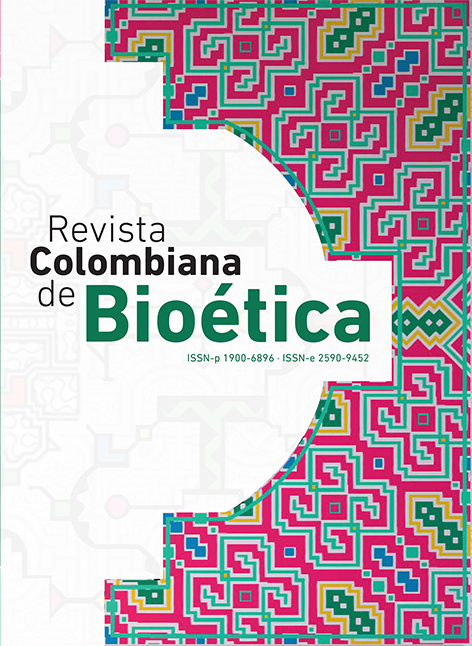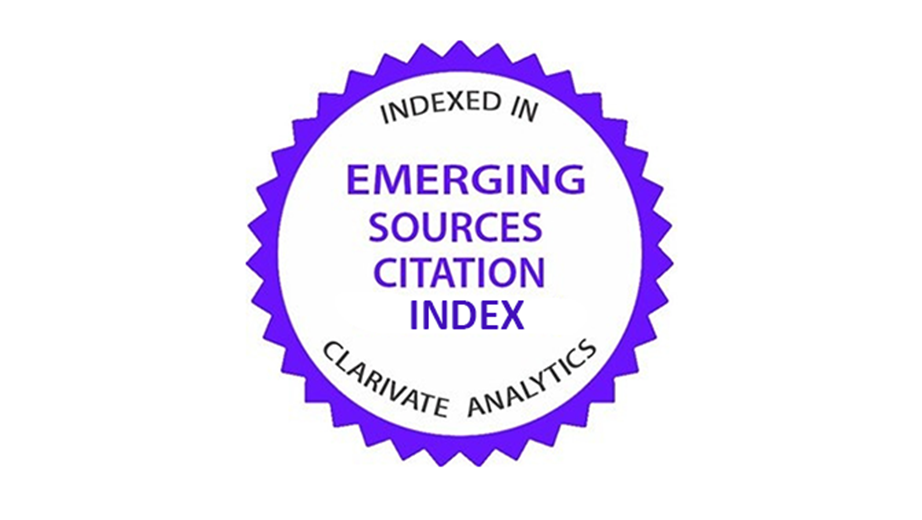Medical and social dehumanization in the face of embryofetal loss in pregnant mothers
DOI:
https://doi.org/10.18270/rcb.v18i2.4568Keywords:
pregnancy, death, communication, sadness, loneliness, empathy, mother, beneficenceAbstract
Purpose/Context. Evidence the existence of medical and social invisibility produced around embryo-fetal losses in pregnant mothers.
Method/Approach. Narrative and bioethical bibliographic review of publications that specifically analyze how pregnant mothers are affected by the way health workers communicate when they must notify the loss of their child due to complications in embryo-fetal development. We review whether the Principles of Bioethics are applied in this communication.
Results/Findings. After the analysis carried out, we found that, frequently, pregnant mothers who suffer these natural abortions often experience an absence of empathy and humanity in health professionals who do not adequately cover – ethically – the magnitude of this loss of the child. that is being developed. We add that this situation is aggravated by the feeling of failure and loneliness, together with the sadness and grief they go through.
Discussion/Conclusions/Contributions. We highlight the ontological and human value that mothers give to the death of the one they consider their child, regardless of the stage of development in which they are. Unforeseen death in the first weeks of pregnancy should not be reduced to a merely physiological accident with no importance at a communicative level. We conclude that it is necessary to advise health professionals through medical and ethical protocols that allow them to address the care of those patients who go through this situation of embryo-fetal loss. We consider from bioethics that, in the face of these critical circumstances, the Principle of Beneficence should be prioritized, given that poor communication negatively affects the physical and mental well-being of these patients.
Downloads
References
Beauchamp, Tom y James Childress. 2019. “Principles of Biomedical Ethics: Marking Its Fortieth Anniversary.” The American Journal of Bioethics 19, no. 11: 9-12. https://doi.org/10.1080/15265161.2019.1665402
Bellhouse, Clare, Meredith J. Temple-Smith y Jade E. Bilardi. 2018. “It’s just one of those things people don’t seem to talk about... women’s experiences of social support following miscarriage: a qualitative study.” BMC Women's Health 18: 176. https://doi.org/10.1186/s12905-018-0672-3
Benoit Bayle. 2002. L’embryon sur le divan. Psychopathologie de la conception humaine. París: Masson.
Boltanski, Luc. 2016. La condición fetal: una sociología del engendramiento y del aborto. Madrid: Akal.
Cabero Roura, Lluis. 2009. “Declaration of the Bioethics Commission of the Spanish Society of Obstetrics and Gynecology on legal interruption of pregnancy.” Documento SEGO 52, no. 1: 67-68. https://doi.org/10.1016/S0304-5013(09)70147-5
Carrera, José María. 2003. “El feto como paciente: nuevos desafíos.” Ginecología y Obstetricia Clínica 4, no. 3: 126-127.
CDC. 2022. “¿Qué es la muerte fetal?” CDC. https://www.cdc.gov/ncbddd/spanish/stillbirth/facts.html
Chichester, Melanie, Lesley Tepner y Denise Côté-Arsenault. 2022. “Nursing Care of Childbearing Families After Previous Perinatal Loss.” Nursing for Women's Health 26, no. 5: 379-388. https://doi.org/10.1016/j.nwh.2022.07.011
Claramunt, M. Ángels, Mónica Álvarez, Rosa Jové y Emilio Santos. 2009. La cuna vacía: El doloroso proceso de perder un embarazo. Madrid: La esfera de los libros.
Clement, Elizabeth, Sarah Horvath, Arden McAllister, Nathanael Koelper, Mary Sammel y Courtney Schreiber. 2019. “The Language of First-Trimester Nonviable Pregnancy.” Obstetrics & Gynecology 133, no. 1: 149-154. https://doi.org/10.1097/AOG.0000000000002997
Consejo General de Colegios Médicos de España. 1990. Código de Ética y Deontología Médica, artículos 25.1 y 25.2. Madrid: Consejo General de Colegios Médicos de España.
Díaz Sánchez, Verónica, María Eloísa García Huete, Dolores Marín Morales y Elena Campo. 2010. “La construcción social del duelo en el aborto espontáneo.” Metas de Enfermería 13, no. 6: 25-32.
Dimitriadis, Evdokia, Ellen Menkhorst, Shigeru Saito, William Kutteh y Jan Brosens. 2020. “Recurrent pregnancy loss.” Nature Reviews Disease Primers 6: 98. https://doi.org/10.1038/s41572-020-00228-z
Dugas, Carla y Valori Slane. 2021. “Miscarriage.” StatPearls [Internet]. Última modificación junio 27, 2022. https://www.ncbi.nlm.nih.gov/books/NBK532992/
García de Madinabeitia, Ana Pía. 2011. “Duelo perinatal: Un secreto dentro de un misterio.” Revista de la Asociación Española de Neuropsiquiatría 31, no. 109: 62. https://doi.org/10.4321/S0211-57352011000100005
Giménez Amaya, José Manuel. 2009. “Neurobiología del vínculo de apego y embarazo.” Cuadernos de Bioética 20, no. 3: 333-338.
Herranz, Gonzalo. 2013. El embrión ficticio. Historia de un mito biológico. Madrid: Palabra.
Herranz, Gonzalo. 2021. “Bioética y desarrollo embrionario.” Persona y Bioética 25, no. 1: 2.
Koopmans, Laura, Trish Wilson, Joanne Cacciatore y Vicky Flenady. 2013. “Apoyo a madres, padres y familias después de la muerte perinatal.” Cochrane 6. https://doi.org//10.1002/14651858.CD000452.pub3
Kowalski, Karen. 1987. Perinatal loss and bereavement. En Women’s Health: Crisis and Illness in Childbearing, editado por Lois Sonstegard, Karen Kowalski y Betty Jennings, 25-42. Nueva York: Grune and Stratton.
León Correa, Francisco. 2007. “El diálogo bioético en las técnicas de reproducción asistida.” Acta Bioethica 13, no. 2: 161-167. https://doi.org/10.4067/S1726-569X2007000200002
López Moratalla, Natalia. 2009. “Comunicación materno/filial en el embarazo.” Cuadernos de Bioética 20, no. 70: 303-316.
Martínez Serrano, Paloma. 2011. “Morir antes de nacer. Experiencias de madres y padres en situación de muerte intraútero y de los profesionales en la atención al proceso de parto.” Reduca (Enfermería, Fisioterapia y Podología) 3, no. 3: 207-233.
Martos-López, Isabel, María del Mar Sánchez-Guisado y Chaxiraxi Guedes-Arbelo. 2016. “Duelo por muerte perinatal, un duelo desautorizado.” Revista Española de Comunicación en Salud 7, no. 2: 300-309. https://doi.org/10.20318/recs.2016.3454
Mastandrea, Paula Belén, María Paula Paragis e Irene Cambra Badii. 2022. “Cine y trayectorias del aborto adolescente en Argentina y España.” Revista Colombiana de Bioética 17, no. 2: e3777. https://doi.org/10.18270/rcb.v17i2.3777
Murray, Judith, Deborah Terry, John Vance, D. Battistutta y Y. Connolly. 2000. “Effects of a program of intervention on parental distress following infant death.” Death Studies 24, no. 4: 275-305. https://doi.org/10.1080/074811800200469
Noia, Giuseppe. 2007. Il figlio terminale. Roma: Nova Millenium.
Organización Mundial de la Salud. 2000. Definitions and indicators in Family Planning Maternal & Child Health and Reproductive Health used in the WHO Regional Office for Europe. Copenhagen: WHO Regional Office for Europe. https://apps.who.int/iris/handle/10665/108284
Pardo Sáenz, José María. 2011. El no nacido como paciente. Pamplona, España: Eunsa.
Pastor Montero, Sonia María, José Manuel Romero Sánchez, Olga Paloma Castro, Juan Carlos Paramio Cuevas, Ana Cristina Toledano Losa y José Alejo Ortegón Gallego. 2013. “Buenas prácticas en atención a la pérdida perinatal.” Paraninfo Digital Monográficos de Investigación. Granada 7, no. 19: 1-7.
Prager, Sarah, Elizabeth Micks y Vanessa Dalton. 2023. “Pregnancy loss (miscarriage): Terminology, risk factors, and etiology.” UpToDate. https://www.uptodate.com/contents/pregnancy-loss-miscarriage-terminology-risk-factors-and-etiology
Rodríguez-Pinilla, Elvira y María Luisa Martínez-Frías. 2010. “Tratamiento farmacológico de la mujer embarazada: fármacos contraindicados durante la gestación.” Semergen 36, no. 10: 579-585. https://doi.org/10.1016/j.semerg.2010.09.003
Romero, S., K. Geiersbach, C. Paxton, N. Rose, E. Schisterman, D. Branch y R. Silver.
“Differentiation of genetic abnormalities in early pregnancy loss.” Ultrasound in Obstetrics & Gynecology 45, no. 1: 89-94. https://doi.org/10.1002/uog.14713
Sánchez Luna, Manuel. 2014. “Current «limit of viability».” Anales de Pediatría 80, no. 6: 346-347. https://doi.org/10.1016/j.anpedi.2014.01.019
Sánchez Zinny, Gloria María. 2004. “El embrión como paciente.” En Ética, bioética y desarrollo. El hombre como ser dependiente, coordinado por Aquilino Cayuela Cayuela, Julián Vara Martín, Francisco Javier Romero y Vicente Villar Amigó, 91-103. Granada, España: Comares.
Sociedad Española de Farmacéuticos de Atención Primaria. 2019. “Medicamentos en el embarazo: ¿qué tenemos que tener en cuenta?” SEFAP. https://www.sefap.org/2019/10/17/medicamentos-en-el-embarazo-que-tenemos-que-tener-en-cuenta/
The American College of Obstetricians and Gynecologists. s. f. “Early Pregnancy Loss.” ACOG. https://www.acog.org/womens-health/faqs/early-pregnancy-loss
Umamanita. 2009. “Guía de atención a la muerte perinatal y neonatal.” Umamanaita. https://www.umamanita.es/guia-de-atencion-a-la-muerte-perinatal-y-neonatal/
Downloads
Published
How to Cite
Issue
Section
License

This work is licensed under a Creative Commons Attribution-NonCommercial-NoDerivatives 4.0 International License.

Esta obra está bajo licencia internacional Creative Commons Reconocimiento-NoComercial-SinObrasDerivadas 4.0.















